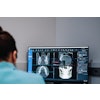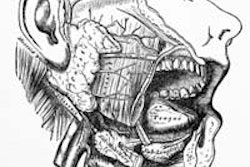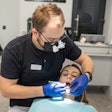
Transoral robotic surgery (TORS) has produced favorable outcomes for the treatment of head and neck cancer (HNC), especially for patients with oropharyngeal cancer, according to a large, international, multicenter study in JAMA Otolaryngology -- Head & Neck Surgery.
 F. Christopher Holsinger, MD. Image courtesy of Stanford University Medical Center.
F. Christopher Holsinger, MD. Image courtesy of Stanford University Medical Center.In this retrospective study, an international team of researchers led by F. Christopher Holsinger, MD, chief of head and neck surgery at the Stanford University Medical Center, reviewed outcomes of TORS in more than 400 patients to identify predictors of disease recurrence and disease-specific mortality.
"In this largest reported series of patients with cancer undergoing TORS, similar findings are observed as in prior studies: Obtaining negative margins is feasible in most properly selected patients," the study authors wrote. "Low rates of positive margins in our current study also demonstrate favorable rates of locoregional control and disease-specific mortality in a larger cohort of patients treated with TORS" (JAMA Otolaryngol Head Neck Surg, September 24, 2015).
Growing rates of oropharyngeal cancer
Nearly 60,000 patients in the U.S. will be diagnosed with head and neck cancer in 2015 (CA: A Cancer Journal for Clinicians, September 16, 2015). Despite decreasing smoking rates, oropharyngeal cancer is increasing, especially in men, and appears related to high-risk HPV, the study authors noted. Between 1988 and 2004, HPV-positive cancers increased by 225%, while HPV-negative cancers decreased by 50%, according to a 2011 study in the Journal of Clinical Oncology. It is now estimated that more than 70% of oropharyngeal cancers have evidence of an HPV infection, the authors wrote.
 The da Vinci robotic surgical system is used in TORS. Image courtesy of Intuitive Surgical.
The da Vinci robotic surgical system is used in TORS. Image courtesy of Intuitive Surgical.Because of the changing epidemiology of the disease and concerns about the toxic effects of radiation, the role of primary surgery has been revisited. Since it was developed at the University of Pennsylvania in 2005, many institutions have found that TORS is safe, with good functional outcomes. In 2009, the U.S. Food and Drug Administration approved the da Vinci robotic surgical system (Intuitive Surgical) for transoral otolaryngologic procedures.
In a 2009 prospective comparative study in Head & Neck, patients treated with TORS had significantly better eating ability two weeks after treatment compared with patients treated with chemoradiation. In addition, surgical patients resumed their oral diets one year after surgery, while patients treated with chemoradiation continued to have decreased oral diets.
Large patient cohort
The current study included 410 patients undergoing TORS for laryngeal and pharyngeal cancers from 2007 to 2012 at 11 medical centers in the U.S., Belgium, and Korea, making it the largest investigation of patients undergoing TORS to treat head and neck cancer, according to the authors.
Of the patients, 364 (88.8%) had oropharyngeal cancer, 106 (31.3%) received radiation therapy alone, and 72 (21.3%) received radiation therapy with concurrent chemotherapy. Most were men (338, 82.4%) with tumors classified as T1 or T2. Alcohol use was common (166, 40.5%), and 159 patients (69.4%) were HPV-positive. Smoking status was known for 338 (82.4%) of the 410 patients. Of the smokers, 27.2% smoked 11 to 19 pack years, 28.1% smoked 20 to 40 pack years, and 19.6% smoked more than 40 pack years.
All patients had TORS for resection of the primary tumor. Eleven (2.7%) previously received radiation alone or chemoradiation and underwent TORS as a salvage procedure. Neck dissection was performed in 323 patients (78.8%). In addition to TORS, 106 (31.4%) of 338 patients also underwent adjuvant radiotherapy, and 72 (21.3%) of 338 patients underwent adjuvant chemoradiation.
Mean follow-up time was 20 months. The researchers reported that 43 patients (10.5%) experienced recurrences, including 33 who had local or regional recurrences, 10 patients (2.4%) had distant metastases. Within the first two years after surgery, 21 patients (5.1%) experienced recurrences. Tonsil primary tumors had the highest rate of locoregional control (p = 0.01).
Benefits of TORS
The study found that patients treated with TORS had better locoregional control of tumors and improved survival rates, based on obtaining negative margins, as compared with other forms of treatment without TORS.
The two- and three-year locoregional control rates for the entire patient cohort were 91.8% and 88.8%, respectively. The greatest difference in locoregional control was seen when comparing patients with positive margins and those with clear margins (p = 0.001). At two-year follow-up, the locoregional control rate for patients with positive margins during TORS was 78.6%, compared with 92.9% when surgical margins were negative. At three-year follow-up, the locoregional control rate for patients with positive margins during TORS was 63.5%, compared with 91.2% when surgical margins were negative.
“The findings ... support the use of TORS as a treatment alternative for select HNCs.”
Overall, there were 30 deaths (7.3%); 17 (4.1%) died of the disease, and 13 (3.2%) died of other causes. The overall survival rate was 91%, and disease-specific survival was 94.5%. The two- and three-year overall survival rates were 91% and 87.1%, respectively. The two- and three-year disease-specific survival rates were 94.5% and 92.5%, respectively.
The researchers found improved survival among women (p = 0.05) and for patients with tumors in the tonsils (p = 0.01). Smoking was associated with worse overall survival (p = 0.01).
As for study limitations, the study was retrospective, and variability in reporting across the treatment centers and missing data regarding pathologic variables may have limited the analyses, according to the study authors. In addition, the mean follow-up time of 20 months may limit definitive conclusions about the outcomes after TORS. However, the authors stated that their results suggest that most recurrences occur within the first two years after treatment.
The authors also noted that the institutions included in the study have expertise with TORS, and that the study results may not be applicable to institutions new to adopting the technology due to the learning curve. Future prospective studies are needed to better delineate the role of TORS in oropharyngeal cancer and to compare the outcomes of this approach with definitive radiotherapy, they wrote. Ongoing prospective clinical trials will provide further information regarding integrating robotic surgery into treatments for optimal patient care, they added.
However, "the findings from the present study support the use of TORS as a treatment alternative for select HNCs," the authors concluded. "Ultimately, our results indicate favorable oncologic outcomes for HPV-positive and HPV-negative groups using a TORS approach."



















